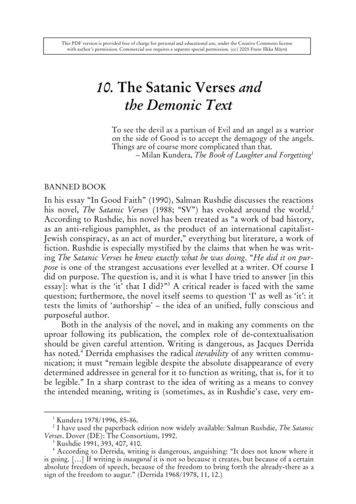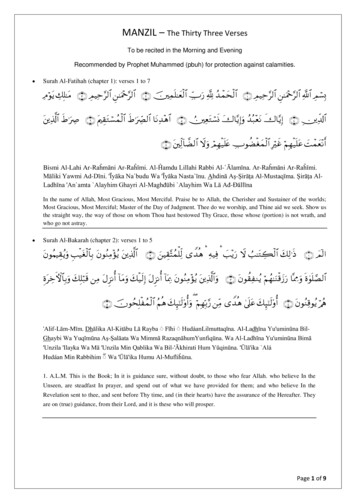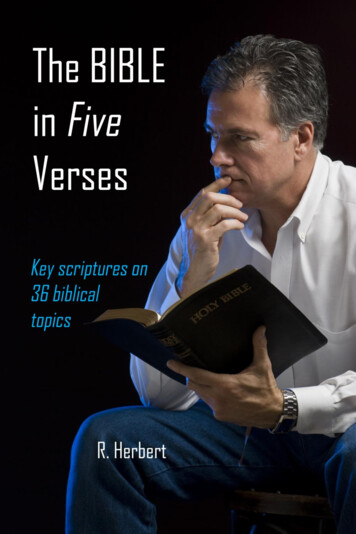
Transcription
This PDF version is provided free of charge for personal and educational use, under the Creative Commons licensewith author’s permission. Commercial use requires a separate special permission. (cc) 2005 Frans Ilkka Mäyrä10. The Satanic Verses andthe Demonic TextTo see the devil as a partisan of Evil and an angel as a warrioron the side of Good is to accept the demagogy of the angels.Things are of course more complicated than that.– Milan Kundera, The Book of Laughter and Forgetting1BANNED BOOKIn his essay “In Good Faith” (1990), Salman Rushdie discusses the reactionshis novel, The Satanic Verses (1988; “SV”) has evoked around the world.2According to Rushdie, his novel has been treated as “a work of bad history,as an anti-religious pamphlet, as the product of an international capitalistJewish conspiracy, as an act of murder,” everything but literature, a work offiction. Rushdie is especially mystified by the claims that when he was writing The Satanic Verses he knew exactly what he was doing. “He did it on purpose is one of the strangest accusations ever levelled at a writer. Of course Idid on purpose. The question is, and it is what I have tried to answer [in thisessay]: what is the ‘it’ that I did?”3 A critical reader is faced with the samequestion; furthermore, the novel itself seems to question ‘I’ as well as ‘it’: ittests the limits of ‘authorship’ – the idea of an unified, fully conscious andpurposeful author.Both in the analysis of the novel, and in making any comments on theuproar following its publication, the complex role of de-contextualisationshould be given careful attention. Writing is dangerous, as Jacques Derridahas noted.4 Derrida emphasises the radical iterability of any written communication; it must “remain legible despite the absolute disappearance of everydetermined addressee in general for it to function as writing, that is, for it tobe legible.” In a sharp contrast to the idea of writing as a means to conveythe intended meaning, writing is (sometimes, as in Rushdie’s case, very em1Kundera 1978/1996, 85-86.I have used the paperback edition now widely available: Salman Rushdie, The SatanicVerses. Dover (DE): The Consortium, 1992.3Rushdie 1991, 393, 407, 410.4According to Derrida, writing is dangerous, anguishing: “It does not know where itis going. [ ] If writing is inaugural it is not so because it creates, but because of a certainabsolute freedom of speech, because of the freedom to bring forth the already-there as asign of the freedom to augur.” (Derrida 1968/1978, 11, 12.)2
250Demonic Texts and Textual Demonsphatically) “repetition to alterity.”5 A written sign “carries with it a force ofbreaking with its context,” and is always drifting away from its author’s intentions and open to new meanings.6 It is Rushdie’s purpose in his essay torestore the novel with its “relevant context”; he tries to explain what sort ofnotion about ‘literature’ governed the production of The Satanic Verses, andto “insist on the fictionality of fiction.”7 Because of his personal predicament, this “restoration” is – albeit elucidating and well justified – somewhatoverdetermined and one-sided. The demonic aspects of this novel’s imageryand textuality make it difficult to construct The Satanic Verses as a “benevolent” and “positive” work – or only that. Rushdie makes a reasonable andsolid plea for positive interpretation. It is, however, possible to appreciatethe conflicting and disruptive aspects of the novel (from the safe distance ofa critical reader, of course). Those features play an important part in thestriking effect that The Satanic Verses has on the reader, and may largely explain how this novel has been such fertile ground for different “misreadings.” My reading of the demonical aspects of The Satanic Verses will at firstoutline its general strategy of hybridisation. My hypothesis is that the demonic elements are used in the novel to dramatise conflicting and problematical aspects in the production of identity. The identity in question can further be analysed to have several different aspects or dimensions in Rushdie’stext, which all contribute to my reading of it as a demonic text, a demonicform of polyphonic textuality.The most visible and far-reaching reaction to Rushdie’s novel was thefatwa (religious/legal judgement) dictated by Ayatollah Khomeini:In the name of Him, the Highest. There is only one God, to whom weshall all return. I inform all zealous Muslims of the world that the authorof the book entitled The Satanic Verses – which has been compiled,printed, and published in opposition to Islam, the Prophet, and the Qur’an– and all those involved in its publication who were aware of its content,are sentenced to death.I call on all zealous Muslims to execute them quickly, wherever theymay be found, so that no one else will dare to insult the Muslim sanctities.God willing, whoever is killed on this path is a martyr.In addition, anyone who has access to the author of this book, but doesnot possess the power to execute him, should report him to the people sothat he may be punished for his actions.May peace and the mercy of God and His blessings be with you.Ruhollah al-Musavi al-Khomeini, 25 Bahman 1367 [February 14, 1989].8The passionate protests against the novel began among the Muslims inIndia even before the novel was officially published. Twenty-two people lost5Derrida 1971/1982, 315.Ibid., 317.7Rushdie 1991, 393, 402.8Pipes 1990, 27 [orig. Kayhan Havai, February 22, 1989]. – The fatwa was officiallyrenounced by the Iranian government almost a decade later, in September 24, 1998.6
The Satanic Verses and the Demonic Text251their lives: rioters were shot in Bombay, the novel’s translators, or just Muslims considered too moderate in their opinions, were assassinated. The incident had major consequences on the commercial and diplomatic relationsbetween Iran and several Western countries. Perhaps more importantly, thecultural relationship between Islam and the secular West was aggravated. Extreme fundamentalism became more confirmed than ever as the dominantWestern perception of Islam.From the Western perspective, the burning of Rushdie’s books and theeffort to silence him with violence were offences towards fundamental human rights.9 From the viewpoint of many Muslims, The Satanic Verses was adirect assault on Islam, abuse of the Koran, the Prophet, and everythingthey considered holy. Rushdie’s novel was clearly able to hit a very sensitivespot in cultural relationships. The different ways to articulate ‘right’ and‘wrong,’ or differences in how ‘human rights,’ or the right way of livingshould be understood, were sharply thematised. This is hardly a coincidence,as The Satanic Verses is openly addressing and discussing these questions inits pages. As Salman Rushdie himself characterises it,If The Satanic Verses is anything, it is the migrant’s-eye view of the world.It is written from the very experience of uprooting, disjuncture and metamorphosis (slow or rapid, painful or pleasurable) that is the migrant condition, and from which, I believe, can be derived a metaphor for all humanity. [ ]Those who oppose the novel most vociferously today are of the opinionthat intermingling with a different culture will inevitably weaken and ruintheir own. I am of the opposite opinion. The Satanic Verses celebrates hybridity, impurity, intermingling, the transformation that comes of new andunexpected combinations of human beings, cultures, ideas, politics, movies, songs. It rejoices in mongrelization and fears the absolutism of thePure.10The most central structuring principle, and an essential aspect of thisnovel’s demonic thematics, is hybridity. The mixture of different cultures,the Indian, the British, the Arabic, is manifest in its cast of characters andmilieu. The opposition and mingling of the religious with the secular is another important area where hybridisation takes place. This opposition andthe systematic breaking of the limit between the sacred and the secular isalso the most notable transgressive feature of the text, and the borderlinewhere the Western and Muslim sensibilities concerning the status of writingcollided. The title of the novel also points towards the ambiguous role thatreligiosity plays in Rushdie’s text.9The article 19 of the Universal Declaration of Human Rights; see e.g. The RushdieLetters: Freedom to Speak, Freedom to Write. Ed. Steve MacDonald & Article 19. (MacDonald 1993.)10Rushdie, “In Good Faith”; Rushdie 1991, 394.
252Demonic Texts and Textual Demons“The Satanic Verses” refers to an episode in the history of Koran,which, before Rushdie’s novel, was almost forgotten.11 A wide range of oldMuslim sources recount that early in his career (about 614 C.E., a year or soafter he began his public preaching), Mohammed confronted resistance towards his monotheistic message especially among the Meccan aristocracy.The Ka’ba was a polytheistic religious centre and the town’s prosperity relied heavily on pilgrims. According to At-Tabari (d. 923), an early historianand commentator on the Koran, Mohammed was asked to acknowledge thethree most important goddesses of Mecca; in return, the nobles would endorse Mohammed’s teaching.12 In the Koran, this question is addressed inSurat an-Najm, verses 19-21:Have you thought upon Lat and Uzza,And Manat, the third, the other?In At-Tabari’s account, Mohammed “hoped in his soul for somethingfrom God to bring him and his tribe together.” Accordingly, he recited thefollowing words of approval:These are the exalted birds,And their intercession is desired indeed.But afterwards the angel Gabriel came to Mohammed and revealed thatthese words were not from God, but from the devil. (At-Tabari tells that“Satan threw on his tongue” those verses, alqa ash-shaytan ‘ala lisanihi.)Promptly, “God cancelled what Satan had thrown.” The words of approvalwere deleted, and the canonical Koran text carries a completely oppositemessage:Have you thought upon Lat and Uzza,And Manat, the third, the other?Shall He have daughters and you sons?That would be a fine division!These are but [three] names you have dreamed of, you and your fathers.Allah vests no authority in them.They only follow conjecture and wish-fulfillment,Even though guidance had come to them already from their Lord.1311In the Islamic tradition this is known as the Gharaniq incident (from the key expression, birds, in the controversial verses). Daniel Pipes (1990, 115) notes that the expression “the Satanic Verses” is unknown in Arabic; it is taken from the Western (orientalist) sources, not from the Islamic tradition, and therefore lays Rushdie open forcharges of orientalism.12Other sources than Tabari include the biographer Ibn Sa’d (d. 845), the collector ofhadith (the Muslim tradition) al-Bukhari (d. 870), and the geographer Yaqut (d. 1229).See Pipes 1990, 56-59. The translations from the Koran here follow the versions used inThe Satanic Verses, and in Pipes’s account.13Koran, Surat an-Najm, verses 19-23.
The Satanic Verses and the Demonic Text253This tale casts serious doubts on the divinity of the Koran; if the holytext was once touched up in the context of political interests, then perhapsother “revelations” had all-too-human motivations, too? It could be claimedthat the messages came to Mohammed in suitable times, and that their content conveniently affirmed the Prophet’s own standpoint. Some orientalistsand sceptics had used the incident to discredit the divine authority of Koranand thereby to shake the very foundations of Islam. The orthodox Muslimresponse (formulated by such thinkers as Muhammad ‘Abduh and Muhammad Husayn Haykal) was to seize the differences in the sources, and to announce the whole episode as apocryphal and a lie.14 Nevertheless, there isstill real ground for discussion; the canonical verses themselves address thequestion of human innovation and the sacred. ‘Lat,’ ‘Uzza’ and ‘Manat’ areclaimed to be “but names you have dreamed of, you and your fathers.” Inother words, even long-held values and traditional deities can be declared asfalse. The concept of “blasphemy” points towards the fundamental incompatibility of faiths: it is the duty of those of the “true” faith to assert theirtruth and to declare void the truths of others. The Koran installs itself as theabsolute truth by the power of its own word (the word of ‘Allah’); thestatus of writing is therefore of great theological importance.Daniel Pipes, the director of Foreign Policy Research Institute inPhiladelphia and an author of many studies of Islam, claims that even the title of Rushdie’s novel was read as blasphemous by the Muslims.Rushdie’s title in Arabic is known as Al-Ayat ash-Shaytaniya; in Persian, asAyat-e Shetani; in Turkish, Şeytan Ayatleri. Shaytan is a cognate for “satan”and poses no problems. But, unlike “verses,” which refers generically toany poetry of scripture, ayat refers specifically to “verses of the Qur’an.”Back-translated literally into English, these titles mean “The Qur’an’s Satanic Verses.” With just a touch of extrapolation, this can be understoodto mean that “The Qur’anic Verses Were Written By Satan.” Simplifying,this in turn becomes “The Qur’an Was Written By Satan,” or just “The Satanic Qur’an.”15The Qur’an/Koran cannot be translated; the Word of Allah was recitedin Arabic.16 Perhaps the same is true for Rushdie’s novel, as well; here, thesimple act of translation and transfer of the title into another language andculture metamorphosed an ironic and dense metafictional text, or a novel of“magical realism,” into something that might be translated as “the Black Bible,” in the Western idiom. The shift from the context of many voices andvalue systems to one where one text dominates and guides reading verypowerfully, effects a radical transformation of Rushdie’s text. “Babel is also14Pipes 1990, 61-62.Ibid., 116-17.16The Arabic name of Koran – Qur’an – means recitation, or text to be read aloud. Itis derived from the verb qara’a (‘to read,’ ‘to recite’) but it probably also has a connectionwith the Syrian word qeryana (‘reading,’ especially of religious lessons). (Räisänen 1986,13, 19.)15
254Demonic Texts and Textual Demonsthis possible impossible step [ce pas impossible], beyond hope of transaction,tied to the multiplicity of languages within the uniqueness of the poetic inscription” has Derrida been (impossibly) translated.17 The sacred texts arenot alone in the dilemma of having something irreducibly untranslatable inthem; the presence of the original context can never be transferred with thetext, thereby the Babel of interpretations is a fact.18 A religious communityis united by shared values and beliefs. The coexistence of competing andconflicting views and voices has traditionally illustrated hell – as opposed tothe one voice and harmony of heaven.19 The Satanic Verses uses demonic imagery in ambiguously self-ironic ways to dramatise how profoundly Westernindividualism becomes positioned as “satanic” when it is opposed to fundamentalist religious ideals.AGAINST THE ORTHODOXYThe criticism of The Satanic Verses has often centred on the discussionwhether the novel is blasphemous, or not. One could make a case that itboth is blasphemous, and not, at the same time. A written text – in this case,a novel – is not just the material object, but (in a much more profoundsense) all the immaterial conditions that shape its reception. In a classicblasphemy trial at Morristown in 1887, Robert G. Ingersoll presented theissue as follows: “[W]hat is blasphemy? Of course nobody knows what it is,unless he takes into consideration where he is. What is blasphemy in onecountry would be a religious exhortation in another. It is owing to whereyou are and who is in authority.” David Lawton, who has adopted thisstatement as an epigram in his study Blasphemy (1993) analyses blasphemyas a particular linguistic act, one which makes visible the implicit limits inthe social systems of meaning. Blasphemy is, according to Lawton, “a placewhere one sees whole societies theorising language.”20 It is, for example,hard to deny the (society’s) unconscious revolt against Christianity in theintense fascination with the fantasy of the “Witches’ Sabbath” in the lateMedieval period. There is an unacknowledged reciprocity between the faithful and the blasphemer according to Lawton; it seems to be true that thefantasies of communion with the Devil, as described by Norman Cohn inhis Europe’s Inner Demons, could only be conceived from within an intimateknowledge of Christianity. “In every respect they [the witches and theirblasphemous activities] represent a collective inversion of Christianity – and17Derrida 1992, 408 (orig. Schibboleth: Pour Paul Celan, 1986).See Derrida 1985 (“Des Tours de Babel”); see also Gen. 11:1-9.19The traditional symbolism saw the division between peace and prosperity (heaven)and turmoil, despair and alienation from the social unity (hell); in a pluralistic and culturally complex modernity the status of heterogeneity has gone through re-evaluation. See:Bernstein 1993 (on the development of ideas concerning hell); Bakhtin 1929/1973 (onthe concept of polyphony, especially pp. 21-26 on Dante).20Lawton 1993, 17.18
The Satanic Verses and the Demonic Text255an inversion of a kind that could only be achieved by former Christians.”21In its self-consciousness, The Satanic Verses can be also seen as a sustainedmeditation on the conditions of blasphemy, how sanctity is constructed andwhat is the role of mockery as its counter-discourse.The thematic foregrounding of borderlines is pervasive in Rushdie’snovel, making it an emphatic dramatisation of possibilities for discursiveconflicts. It should be pointed out that The Satanic Verses is not “Satanic” inthe traditional, one-dimensional sense of advocating some “anti-truth,” ordeveloping a simple reversal of religious (Islamic) identity. Instead, it explores the difficulties of constructing any stable identities in a context thatcould be best described as post-modern. This can be illustrated by analysingthe diverse ways in which the demonic elements are applied at the novel’stexture. The most important single feature in this area, and one that affectseverything else, is the systematic juxtaposition and blending of the religiousand the profane, and the self-conscious commentary about this process.Question: What is the opposite of faith?Not disbelief. Too final, certain, closed. Itself a kind of belief.Doubt.[ ] [A]ngels, they don’t have much in the way of a will. To will is todisagree; not to submit; to dissent.I know; devil talk. Shaitan interrupting Gibreel.Me?22This quotation comes from an important intersection in the novel; thechapter titled “Mahound” introduces the controversial sections, and thismeditation on the devil and the will is prominently situated in the beginningof it. Rushdie’s text in this point does not address the total opposite of religious faith, it is not indifferent or unsympathetic towards the religious tradition. Instead, it articulates a middle ground between secularism and religiosity by exploring the religious elements with an involved but critical attitude.Thereby, the question of the narrator (“Shaitan [ ] Me?”) becomes a realpoint of inquiry. Not the angelic, nor the satanic, but the demonic traditionwith its emphasis on the plurality and polyphony of subjectivity is able toillustrate the complexities of this position. The fundamentalist constructionof religious identity, which cannot tolerate any doubt, critique or even individual will, renders the essential heterogeneity of the human condition as“devil talk.” The Satanic Verses asks whether, under this sort of discursivecondition, the self (as the speaking subject) should be identified with “Shaitan.”2321Cohn 1975/1993, 147.SV, 92-93.23“Shaytan is a pagan Arabic term possibly derived from the roots ‘to be far from’ or‘to born with anger.’ Under Jewish and Christian influence, Muhammad defined the termin relation to its Hebrew cognate satan, ‘opponent’ or ‘obstacle.’ The Qur’an also describes him as accursed, rejected, and punished by stoning. He is a rebel against God. The22
256Demonic Texts and Textual DemonsThe prominence of the demonic elements in the novel may appear perverse from an orthodox religious perspective. The novel, however, presentsits own motivations. Religion is a communal matter in The Satanic Verses, itis assigned the intermediary role between specific personal concerns and thepublic and shared material of a culture. Therefore it is submitted to an ideological inquiry; this is what the use of ‘dissent’ signals above. It is a conceptwith a dual history in the political parlance as well as in the field of religion.Whereas political ‘dissidence’ is an important concern of liberal Western activism, the religious dissenter refuses to conform to the doctrines of orthodoxy or the established Church.24 Traditionally, the dissidents have beenperceived as serious threats by both the political and religious orthodoxy,and the measures towards heretics and political trouble-makers have beenforceful. Some prominent elements in The Satanic Verses ally themselveswith such rebels and subjugated groups, and present the choice of demonicelements as a political act. For example, the Prophet makes an appearance inRushdie’s novel as “Mahound;” this is the Medieval Christian contortion of“Mohammed.” It signifies otherness to the point of having been used as asynonym for the devil.25His name: a dream-name, changed by the vision. Pronounced correctly, itmeans he-for-whom-thanks-should-be-given, but he won’t answer to thathere; not, though he’s well aware of what they call him, to his nickname inJahilia down below – he-who-goes-up-and-down-old-Coney. Here he is neither Mahomet not MoeHammered; has adopted, instead, the demon-tagthe farengis hung around his neck. To turn insults into strengths, whigs,tories, Blacks all chose to wear with pride the names they were given inscorn; likewise, our mountain-climbing, prophet-motivated solitary is tobe the medieval baby-frightener, the Devil’s synonym: Mahound.26The change of name signals the change of discursive rules: it is the narrator’s way of saying ‘This should be read differently, not according to thepractise shaped by the holy text. This is a dream, fiction.’ Those elementsthat mark the difference – Mohammed transformed into ‘Mahound,’ Islamtranslated into ‘Submission’ (with this word’s negative connotations in thename Shaytan appears much more frequently in the Qur’an than does Iblis [the othername for the devil], usually in connection with the tempting and seduction of humans;the term shayatin in the plural also appears as the equivalent of Christian demons, evilspirits who are followers of the evil leader.” (Russell 1984, 54.)24‘Dissent’ comes from the Latin dissentire, to differ. Cf. dissidere, to sit apart, to disagree. (New Webster’s Dictionary.)25The Oxford English Dictionary gives five, now antiquated uses for ‘Mahound’ (mostexamples date from the fifteenth century): 1) The ‘false prophet’ Muhammed; in theMiddle Ages often vaguely imagined to be worshipped as a god; 2) A false god; an idol;3) A monster; a hideous creature; 4) Used as a name for the devil; 5) Muslim, heathen.(Oxford English Dictionary 1989, q.v. ‘Mahound.’)26SV, 93. – “Coney” is associated for an Indian reader with “cunt,” bringing an additional blasphemous potential in play. (I am grateful to Professor Alphonso Karkala forthis remark.)
The Satanic Verses and the Demonic Text257“free West”), Mecca reincarnated as ‘Jahilia’ (ignorance), etc. – are not neutral modifications. They all have distinctly pejorative traits. David Lawtonfollows Jonathan Dollimore as he writes that “organised religion encountersin a blaspheming rival ‘a proximity rooted in their differences’.”27 Rushdie’stext displays openly its proximity to Islam, using it to stir discussion aboutthe different interpretations of “community.” The justification for stigmatised terms is overtly political; furthermore, “whigs, tories, Blacks” are partof the Western (British and American) political past and the polyculturalpresent. They suggest a history of political debate and dialogue, as well as ofone governed by colonialism; the narrator also alludes to the struggle of minorities in the postcolonial situation. Name-calling has a different status inthis context; the horizon of immutable truths and sanctity is interlaced inthis brief section with the perspective of conflicting human interests, whichmakes all claims for one, holy and privileged view appear as dubious. Thereis subtle irony in the words the young immigrant girl, Mishal, speaks toSaladin Chamcha, who has metamorphosed into the shape of Satan: “I mean,people can really identify with you. It’s an image white society has rejectedfor so long that we can really take it, you know, occupy it, inhabit it, reclaimit and make it our own.”28The opposition and mixing of the religious and the political points towards two ways of perceiving language and writing: static and dynamic.Whereas Koran denies all authority from “names you have dreamed of, youand your fathers,” the situation and characters as presented in The SatanicVerses cannot adopt any truths as preordained, or God-given. Other people’sbeliefs, the sphere of human invention, and therefore, of change – all theseare combined with the question of language. As we read from the stream-ofconsciousness of Jumpy Joshi, a character with poetic aspirations: “The reallanguage problem: how to bend it shape it, how to let it be our freedom, how torepossess its poisoned wells, how to master the river of words of time of blood[ ].”29 The main characters of The Satanic Verses are living among many religions, between conflicting cultures and values. This heterogeneity isheightened by the fact that most of them are immigrants, people of Indianorigin in Britain. Any meanings cannot be taken as given, because the sharedlanguage, English, is not “their” language, originally. Every word of it is alienbecause of its Western heritage; it is steeped in the history of colonialism.Hami K. Bhabha has written aptly: “Salman Rushdie’s The Satanic Verses attempts to redefine the boundaries of the western nation, so that ‘foreignnessof languages’ becomes the inescapable cultural condition for the enunciationof the mother-tongue.”30 This can be compared with Rushdie’s own formulation (as quoted above) that it is “the migrant condition” from which“could be derived a metaphor for all humanity.” Basically, The Satanic Verses27Lawton 1993, 144-45; Dollimore, Sexual Dissidence (1991, 18).SV, 287.29SV, 281. Italics in the original.30Bhabha 1994, 166 (also 1990, 317; and quoted in Lawton 1993, 186).28
258Demonic Texts and Textual Demonsdefines (post)modern subjectivity as something that arises from heightenedawareness of language, and from recognition of “self” as being somethingdefined and redefined by language.We can conclude from this emphasis on the British context and theimmigrant experience, that the Koran itself is not among the real “targets”of Rushdie’s subversive text, but rather the fundamentalist interpretation ofit, as perceived from the “migrant condition.” The change of Islamic names,characters and narratives are nowhere as radical as are the transformationssituated in the Great Britain.The manticore ground its three rows of teeth in evident frustration.‘There’s a woman over that way,’ it said, ‘who is now mostly waterbuffalo. There are businessmen from Nigeria who have grown sturdy tails.There is a group of holidaymakers from Senegal who were doing no morethan changing planes when they were turned into slippery snakes. I myselfam in the rag trade; for some years now I have been a highly paid malemodel, based in Bombay, wearing a wide range of suitings and shirtingsalso. But who will employ me now?’ he burst into sudden and unexpectedtears. [ ]‘But how they do it?’ Chamcha wanted to know.‘They describe us,’ the other whispered solemnly. ‘That’s all. They havethe power of description, and we do succumb to the pictures they construct.’31Saladin Chamcha was born Salahuddin Chamchawala, and after changing his name to adopt a career in the West, he has undergone a completephysical transformation, as well. It should be pointed out, that despite thecruel and distressing situation, this section carries its own, absurd humour.Chamcha is described as having hairy goat-legs, a tail and an over-sized phallus as the Pagan fertility god, Pan, and he is called “Beelzebub” or “devil”even by his friends. The main emphasis, however, is not laid on the religioustradition in this section, or on how religious ideas can alter one’s identity.Western philosophical ideas, and the contemporary discussion on how theconceptual representations of reality take part in creating the reality they tryto convey, are the main source of humour here. Especially a reference to therole of Nietzsche and his theory of truth is pertinent here, as the lives ofRushdie’s left-wing intellectuals are immersed in radical discourses, many ofwhich owe something to Nietzsche. Compare Rushdie to the following quotations:What, indeed, does man know of himself! Can he even once perceive himself completely, laid out as if in an illuminated glass case? Does not naturekeep the most from him, even his body, to spellbind and confine him in aproud, defective consciousness [ ].31SV, 168.
The Satanic Verses and the Demonic Text259What, then, is truth? A mobile army of metaphors, metonyms, and anthropomorphisms – in short, a sum of human relations [ ]. [T]ruths areillusions about which one has forgotten that this is what they are; metaphors which are worn out and without sensuous power; coins which havelost their pictures [ ].32The pathos and drama of such radicalism are both illustrated to thereader and distanced from him by the simultaneous effects of irony and fantast
Jewish conspiracy, as an act of murder,” everything but literature, a work of . In addition, anyone who has access to the author of this book, but does not possess the power to execute him, should report him to the people so . and sceptics had used the incident to











